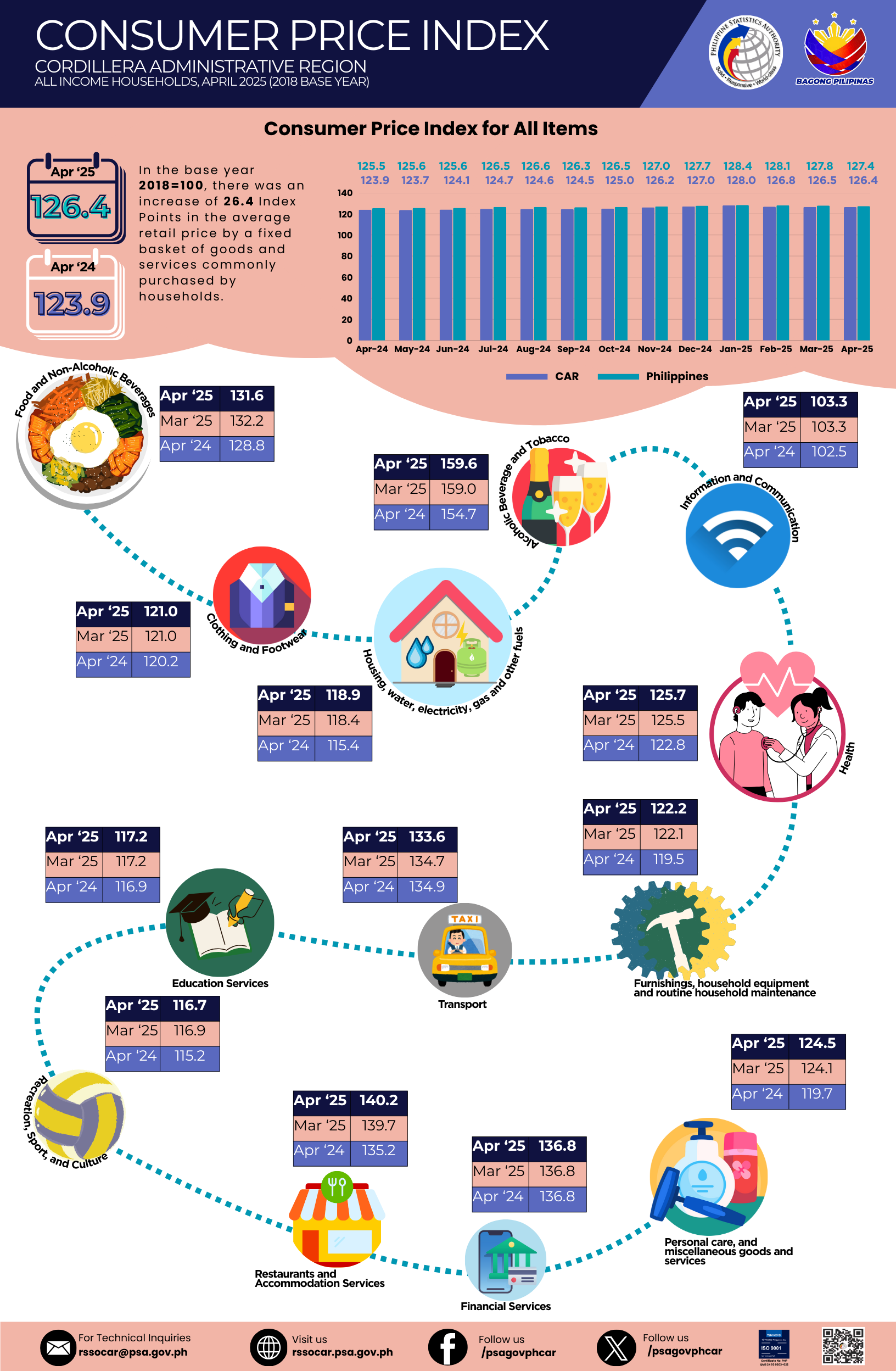Consumer Price Index
Consumer Price Index (CPI) is the general measure of the change in the average retail prices of a market basket or collection of goods and services commonly purchased by the average Filipino household.
In general, the CPI increased reflecting the rise in the average prices of goods and services in all the six provinces and Highly Urbanized City (HUC) of CAR.
The CPI of the Cordillera Administrative Region (CAR) in March 2023 was 118.9 index points. This was higher by 6.3 index points from the 112.6 CPI index points in March 2022, using
2018 as base year.
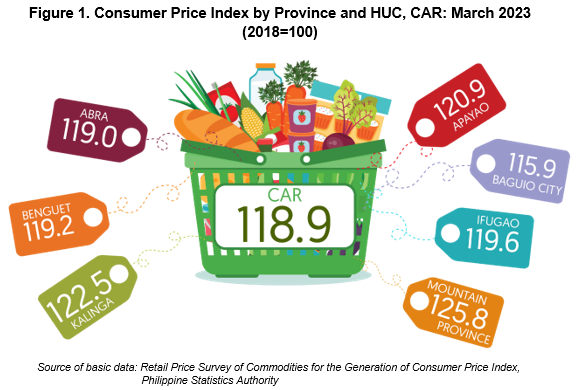
Among the CAR provinces and HUC, Mt. Province posted the highest CPI for March 2023 with 125.8 index points, followed by Kalinga with 122.5 index points, and Apayao with 120.9 index points.
Meanwhile, Baguio City posted the lowest CPI with 115.9 index points.
CPI by Commodity Groups
Among the commodity groups, Alcoholic Beverages and Tobacco had the highest CPI in the region with 147.2 index points. The province of Kalinga incurred the highest CPI on this commodity with 172.8 index points, followed by Mt. Province with 167.7 index points, and Abra with 163.7 index points.
Financial Services ranked second among the commodity groups in the region in March 2023 with 139.2 index points. Among the provinces, Abra had the highest CPI on this commodity with 160.4 index points while Ifugao and Mt. Province had the lowest CPI, both with 100.0 index points.
Transport registered the third highest CPI commodity group in the region with 129.4 index points. Apayao recorded the highest index for this commodity with 140.9 index points, followed by Benguet and Ifugao with 140.1 index points, and 129.5 index points, respectively.
Information and Communication incurred the lowest CPI among the commodity groups in the region during the month of March 2023 with 102.0 index points. The province of Apayao incurred the highest CPI on this commodity with 103.3 index points while Mountain Province had the lowest CPI with 99.8 index points.
Among the provinces and HUC in the region, Mountain Province incurred the highest CPI for All Items with 125.8 index points while Baguio City recorded the lowest CPI with 115.9 index points in March 2023.
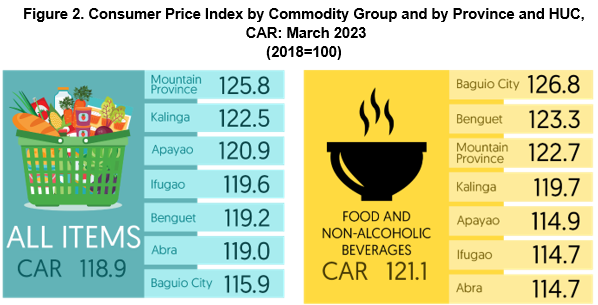
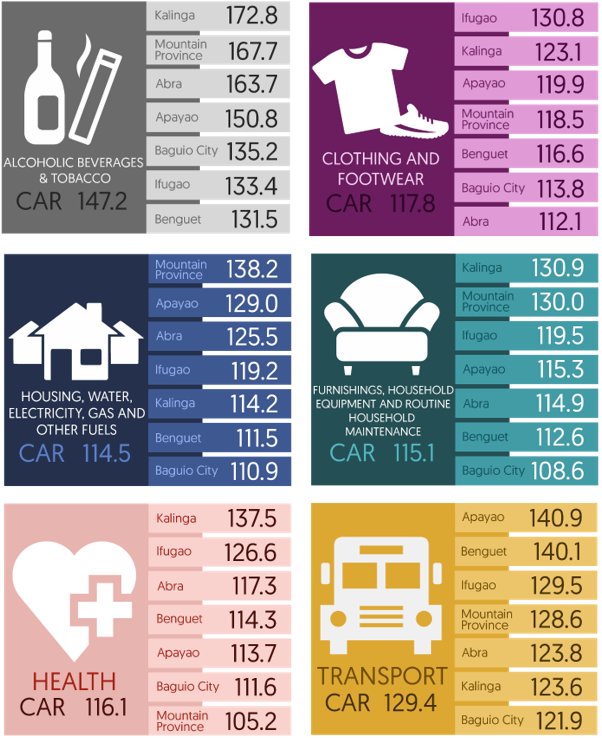
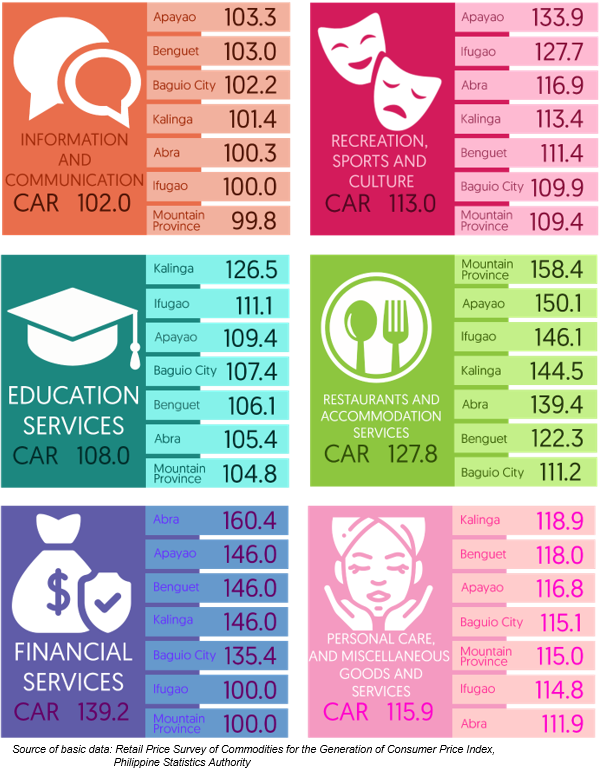
By index point change, almost all commodity groups in March 2023 incurred increases in index point compared to the previous year. Alcoholic Beverages and Tobacco recorded the highest increase with 13.1 index points. This was followed by Transport, and Food and Non-Alcoholic Beverages with 10.0 and 9.4 index point changes, respectively.
Financial Services posted no changes on index points in March 2023.
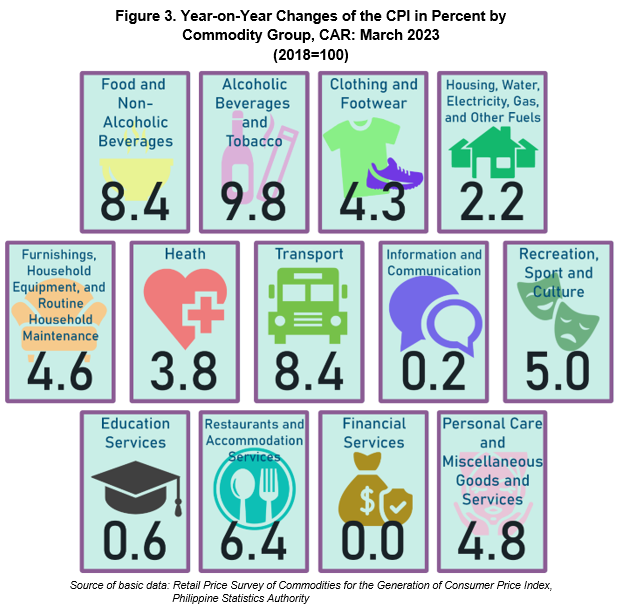
In March 2023, Alcoholic Beverages and Tobacco recorded the highest increase of CPI with 9.8 percent from the same month of the previous year. This was followed by Food and Non-Alcoholic Beverages, and Transport, both with 8.4 percent.
Financial Services incurred no increase of CPI for March 2023.
CPI Market Basket
Since it is virtually impossible to have periodic measures on the changes in the prices of all the thousands of varieties of goods and services purchased for consumption and services availed by households, a sample of these items, known as the “CPI market basket,” was selected to represent the composite price behavior of all goods and services purchased by consumers.
The Cordillera region contributes 1.63 percent of goods and services in the national market basket.
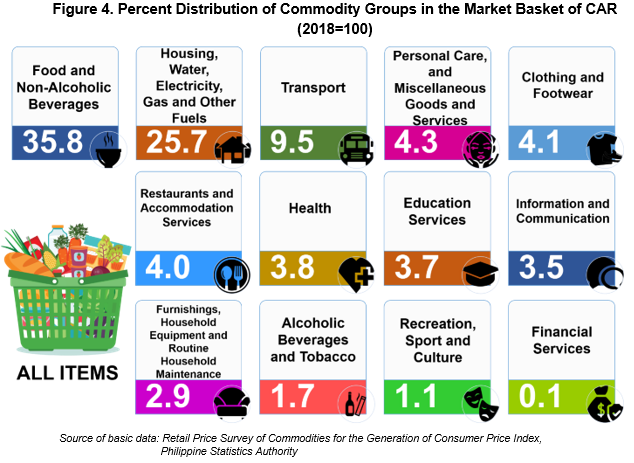
Among the goods and services in the market basket of the Cordillera region, Food and Non-Alcoholic Beverages had the highest share with 35.8 percent. This was followed by Housing, Water, Electricity, Gas and Other Fuels with 25.7 percent, and Transport with 9.5 percent.
Financial Services had the least share in the market basket of CAR with only 0.1 percent.
Inflation Rate
The inflation of the prices of goods and services in the region decelerated to 5.6 percent in March 2023, from 7.1 percent in February 2023. Meanwhile, this was higher by 0.5 percentage points compared to March 2022 with 5.1 percent.
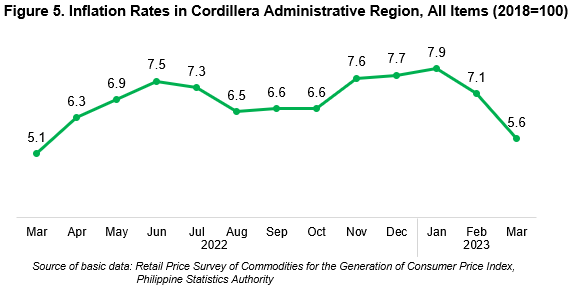
Main Drivers to the Downward Trend of the Region’s Inflation
Out of the thirteen (13) commodity groups in the market basket of the region, seven (7) of them were the main drivers of the region’s inflation rate downtrend in March 2023 from the previous month. These were mainly brought by the Food and Non-Alcoholic Beverages that recorded a lower inflation rate of 8.4 percent compared to 10.1 percent in the previous month. This was followed by Housing, Water, Electricity, Gas, and Other Fuels with an inflation rate of 2.2 percent from 4.1 percent the previous month. The third primary driver to the downtrend of the inflation during the month was Transport with an inflation rate of 8.4 percent from 13.5 percent in February 2023.
Other commodity groups that contributed to the downtrend of inflation of the Cordillera region in March 2023 were Restaurant and Accommodation Services with 6.4 percent, Personal Care and Miscellaneous Goods and Services with 4.8 percent, Clothing and Footwear with 4.3 percent, and Health with 3.8 percent, compared with their previous month’s higher inflation rates.
On the other hand, higher inflation rates were observed in Alcoholic Beverages and Tobacco with 9.8 percent from 9.5 percent; Furnishings, Household Equipment and Routine Household Maintenance with 4.6 percent from 4.4 percent; and, Recreation, Sport and Culture with 5.0 percent from of 4.9 percent in February 2023.
The inflation rates of Information and Communication, Education Services, and Financial Services retained their corresponding previous month’s annual increments with 0.2 percent, 0.6 percent, and 0.0 percent, respectively.
Main Contributors to the Region’s Inflation
In terms of contribution to the March 2023 inflation rate in the Cordillera region, the main contributor was Food and Non-Alcoholic Beverages with 54.3 percent of the market basket. This was followed by Transport, and Housing, Water, Electricity, Gas and Other Fuels with 14.5 percent and 10.2 percent, respectively.
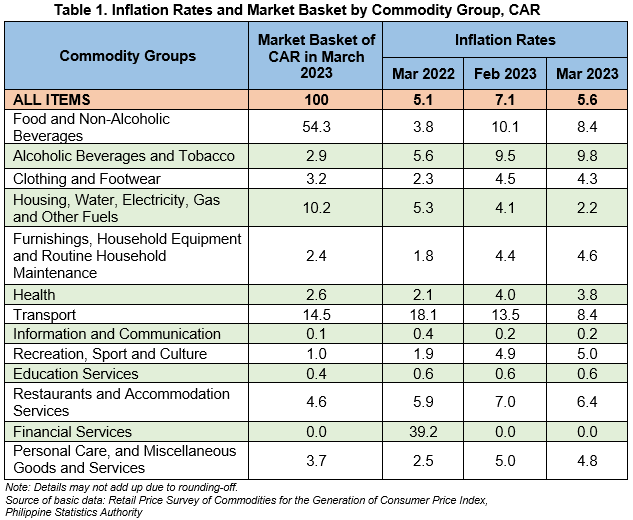
Among the provinces and HUC in the region, Apayao posted the highest inflation rate in March 2023 with 9.5 percent. This was followed by Mt. Province with 8.3 percent, and Abra and Kalinga, both with 7.6 percent. Baguio City incurred the lowest inflation rate with 4.3 percent.
All the provinces in the Cordillera region except Benguet and Baguio City recorded higher inflation rates in March 2023 compared to the same month of the previous year.
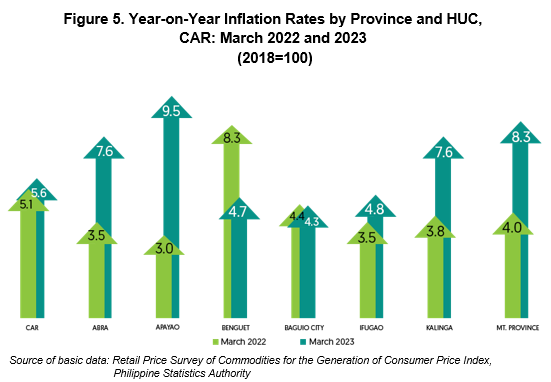
Purchasing Power of the Peso (PPP)
The Purchasing Power of the Peso (PPP) in all the provinces and HUC in the region generally weakened in March 2023 compared to the same month of the previous year.
The value of one (1) peso in the region was 84 centavos in March 2023. It dropped by five (5) centavos from 89 centavos in March 2022. Among the provinces and HUC, Baguio City had the highest peso value with 86 centavos, followed by Abra, Benguet, and Ifugao with 84 centavos. Meanwhile, Mountain Province had the lowest peso value with 79 centavos.
The basket of goods and services in the Cordillera region that can be bought with 100 pesos in March 2018 was worth 118.9 pesos in March 2023.
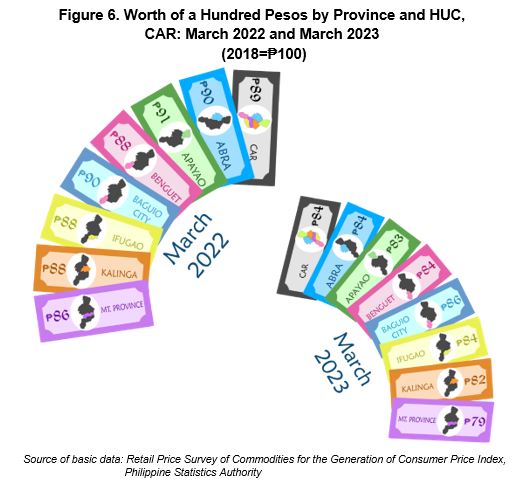
(SGD)
VILLAFE P. ALIBUYOG
Regional Director
__________________________________________________
TECHNICAL NOTES
Consumer Price Index (CPI) is a general measure of the change in the average retail prices of a market basket or collection of goods and services commonly purchased by the average Filipino household.
Inflation Rate (IR) is the rate of change in the average price level between two periods (year-on year/month-on-month as measured by the CPI).
Purchasing Power of the Peso (PPP) measures how much the peso in the reference year is worth in another year.
Base Year (BY) is the reference point of the index number series, at which the index number is set to 100. It is the reference point of the index number series.
The CPI is now rebased to 2018 base year from the 2012 base year. The year 2018 was chosen as the next base year because it was the latest year when the Family Income and Expenditure Survey (FIES) results were made available.
The rebasing of the CPI is done periodically by the PSA due to the following: 1) to ensure that the CPI market basket continues to capture goods and services commonly purchased by households over time; 2) to update expenditure patterns of households; 3) to synchronize its base year with 2018 base year of the Gross Domestic Product and other indices produced by PSA such as the Producer Price Index (PPI) for Agriculture; PPI for Manufacturing; and Value of Production Index (VaPI), Volume of Production Index (VoPI), and Value of Net Sales Index (VaNSI) for Manufacturing.
Market Basket (MB) is a sample of goods and services used to represent all goods and services produced or bought by the households.



